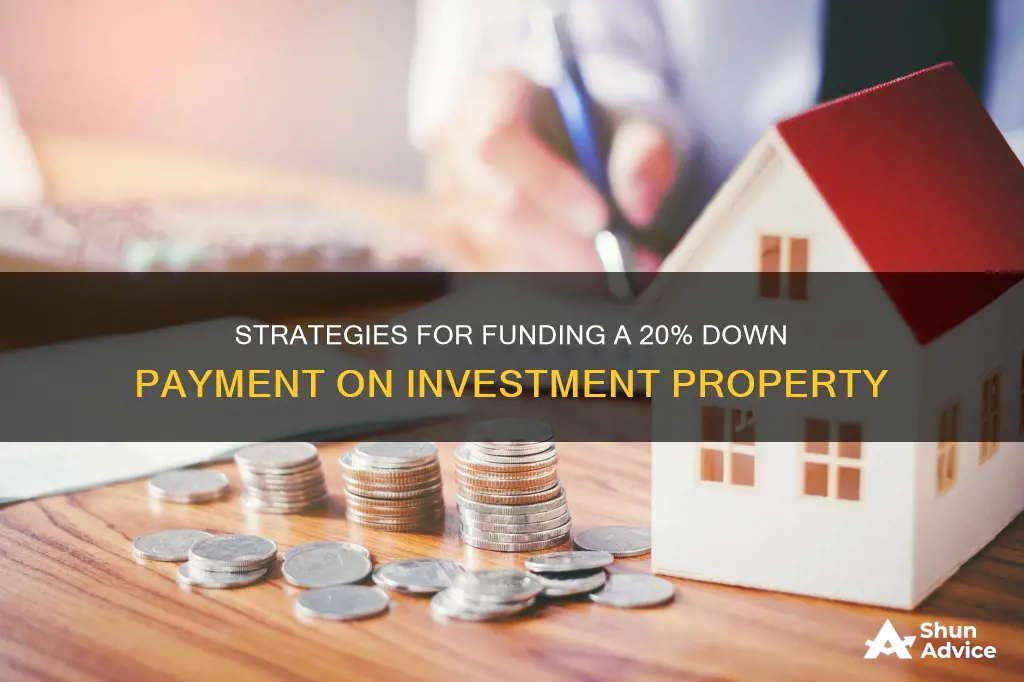
Saving for a down payment on an investment property can be challenging, but there are strategies to help you reach your goal. In this guide, we will explore various options for funding a 20% down payment on an investment property, including both traditional and creative approaches. Understanding these methods will empower you to make informed decisions and take the first step towards building your real estate investment portfolio. Whether you're a first-time investor or a seasoned pro, read on to discover how to secure the necessary funds for your next venture.
| Characteristics | Values |
|---|---|
| Minimum Down Payment | 15-25% |
| Loan Types | Conventional, FHA, VA, USDA, HELOC, Portfolio, Bridge, Fix-and-Flip, Construction, Hard Money |
| Lender Requirements | Credit Score, Debt-to-Income Ratio, Cash Reserves, Investment Experience, Income |
| Alternative Options | Seller Financing, Private Lenders, Self-Directed IRA, Group Investing, Unsecured Business Credit, Retirement Accounts |
What You'll Learn

Explore non-traditional financing methods
When it comes to financing an investment property, there are several non-traditional methods you can explore to secure the necessary funds for your down payment. Here are some alternative financing strategies to consider:
- Portfolio loans: These are offered by portfolio lenders, who create their own approval standards since they don't resell the investment property loans they originate. Portfolio lenders often cater specifically to real estate investors and may be more willing to work with borrowers who have lower credit scores or higher debt-to-income ratios than conventional lenders would accept. While interest rates and loan fees may be higher due to the increased risk, it could be worth it to secure a good deal on an investment property.
- Occupant loan programs: These programs offer flexible payment requirements, allowing you to put down less than the standard 20% down payment. This option is particularly useful if you plan to live in one of the units of a multi-unit investment property.
- Private lenders: Private lenders often provide more flexible funding solutions for investment properties compared to traditional lenders. They secure the debt through the property as collateral and may even offer down payment loans. You can find private lenders by joining local real estate groups and networking with other investors.
- Self-directed IRA (SD-IRA): By converting a traditional IRA or 401(k) into an SD-IRA, you can use the funds to purchase rental property. This option typically requires more paperwork and ongoing compliance with tax laws, so be sure to consult a tax professional for guidance.
- Joint ventures or LLCs: You don't have to invest in real estate alone. Consider forming a joint venture or LLC with other partners who are willing to contribute cash for the down payment in exchange for a share of the monthly cash flow and future profits. This option allows you to pool resources and share the risks and rewards of investing.
- Bridge loans: Bridge loans are short-term financing solutions commonly used by real estate investors to secure the funds needed for a down payment. Once the deal is done, you can seek a more favourable long-term loan, such as a conventional loan for an investment property.
- Seller financing: Also known as owner financing, this option involves negotiating directly with the property owner, who acts as the lender. Seller financing can provide flexibility in terms and conditions, including down payment requirements. Carefully consider the interest rates, repayment schedules, and any specific clauses attached to the sale agreement.
- Lines of credit: You can leverage existing credit lines, such as personal loans, business credit cards, or cash advances, to cover the down payment. This approach allows you to preserve your cash flow while still accessing the necessary funds. Just be sure to assess your financial situation and ensure that taking on additional debt aligns with your long-term investment goals.
- Home equity: You can access the equity in your home through a cash-out refinance or a Home Equity Line of Credit (HELOC) to fund your down payment. With a cash-out refinance, you replace your existing mortgage with a new one with a higher loan amount and receive the difference in cash. A HELOC, on the other hand, allows you to borrow against the value of your home up to a certain limit. Keep in mind that utilising home equity can increase your mortgage debt and carry associated costs, so be sure to weigh the benefits against these potential drawbacks.
Remember to carefully evaluate each non-traditional financing option based on your financial situation, investment goals, and the potential risks and benefits involved.
Endowments Hedge: Why Endowments Invest in Hedge Funds
You may want to see also

Diversify your funding sources
When it comes to funding a 20% down payment on an investment property, diversifying your funding sources can be a smart strategy. Here are some ways to achieve that:
Combine Savings with Other Methods
Don't put all your eggs in one basket. Instead of relying solely on one source for funding, consider combining savings with other methods. This could include tapping into multiple sources, such as personal savings, investments, or even borrowing from family and friends. By diversifying your funding sources, you can reduce the financial burden on any single source and increase your chances of reaching your down payment goal.
Explore Different Loan Options
There are various loan options available beyond conventional mortgages. Look into non-traditional methods such as portfolio loans or occupant loan programs. These alternatives often have more flexible payment requirements, allowing you to put down less than the standard 20%. Seek out portfolio lenders who cater specifically to real estate investors and may be more willing to work with borrowers who have lower credit scores or non-traditional financial profiles.
Utilize Home Equity
If you already own a home, consider leveraging the equity you've built up. You can do this by taking out a home equity loan or a home equity line of credit (HELOC). This will allow you to borrow against the value of your home to cover the down payment on your investment property. Just be sure to carefully consider the associated costs and potential impact on your existing mortgage terms.
Partner with Others
Consider finding like-minded individuals or groups who share your investment goals and are willing to contribute financially. Forming partnerships or joint ventures can help you pool resources and spread the financial burden. However, always remember to set clear terms and manage expectations to avoid potential conflicts down the line.
Explore Creative Financing Options
Think outside the box when it comes to financing. For example, you could look into seller financing, where the property owner acts as the lender and negotiates more flexible terms. Alternatively, you could explore options like bridge loans, which are short-term financing solutions that can help you secure the funds needed for the down payment.
Remember, when diversifying your funding sources, it's important to carefully evaluate each option based on your financial situation, risk tolerance, and long-term goals. It's always a good idea to consult with professionals in real estate and finance to ensure you make well-informed decisions.
High Net Worth Investors: Hedge Funds for Long-Term Growth
You may want to see also

Seek portfolio lenders
Seeking portfolio lenders is a great strategy when looking to fund a 20% down payment on an investment property. Portfolio lenders are typically small, privately owned community banks or financial institutions that offer more flexibility and customised loan programs for borrowers.
Portfolio lenders work differently from traditional lenders. They originate mortgage loans and keep the debt in their portfolio of loans instead of reselling it on the secondary market. This means they are not beholden to the demands of outside investors and can set their own approval criteria, which may include more flexible repayment terms, smaller down payments, and unique loan structures. This flexibility can be advantageous for real estate investors who want to purchase older homes to renovate.
Additionally, portfolio lenders often consider borrowers with lower credit scores or higher debt-to-income ratios, making them a viable option for those who don't meet the stringent requirements of conventional lenders. Their approval criteria are generally based on evidence of income or assets beyond basic wages, and they may be more forgiving of bankruptcies or other credit history issues.
However, it's important to note that portfolio lenders typically charge higher interest rates and fees to compensate for the increased risk they take on by holding onto the loans. They may also impose prepayment penalties and be harder to find, often requiring the assistance of a mortgage broker.
When seeking a portfolio lender, consider the following:
- Compare portfolio lenders and loan estimates, including how their offers stack up against traditional loan products.
- Evaluate each lender's level of customer service and their willingness to work with you to meet your specific needs.
- Be prepared to shop around and compare multiple loan requirements, interest rates, origination fees, and mortgage terms and conditions.
- Don't hesitate to reach out to local lenders or your own bank to enquire about portfolio lending options.
By seeking out portfolio lenders, you can explore more flexible financing options for your investment property and potentially secure a loan that aligns with your financial situation and goals.
Oil Fund Investment: A Smart Financial Move?
You may want to see also

Consider mortgage insurance
If you are unable to meet the minimum down payment requirement for an investment property, mortgage insurance can be a viable option to secure financing. While it will increase your monthly payments, it allows you to make a smaller upfront payment. This option is particularly useful if you don't have a large sum of cash available for the down payment.
Mortgage insurance protects the lender in case you default on your loan. Typically, lenders require mortgage insurance when the down payment is less than 20% of the property's purchase price. This insurance lowers the lender's risk and can make them more likely to approve your loan. However, it's important to note that mortgage insurance does not protect you, the borrower, but the lender.
When considering mortgage insurance, it's essential to evaluate the additional cost it will bring to your monthly payments. This cost can vary depending on the loan amount, down payment, and credit score. You should carefully review the terms and conditions of the mortgage insurance policy to understand the financial implications.
Additionally, it's worth noting that mortgage insurance may not be permanent. In some cases, you may be able to cancel the insurance once you have built enough equity in your home. This can be achieved by regularly paying down your mortgage balance or if the property's value increases over time.
Before opting for mortgage insurance, it's advisable to consult with a financial professional to ensure it aligns with your long-term financial goals and that you understand the associated risks and benefits.
Fidelity Funds: Choosing the Right Investment for You
You may want to see also

Find good deals with favourable terms
Finding good deals with favourable terms is a crucial aspect of investing in real estate. Here are some strategies to help you achieve this:
- Seller Financing: This is one of the most effective strategies. Instead of relying on traditional lenders, negotiate directly with the property owner for favourable terms. The owner becomes your lender and finances part or all of the purchase price, reducing or eliminating the need for a large upfront payment. Carefully consider factors such as interest rates, repayment schedules, and any specific clauses in the sale agreement.
- Lease-to-Own Arrangements: These deals can help bridge the gap between your available funds and the required down payment. You rent the property with an option to buy it later, allowing you to build equity while renting.
- Portfolio Lenders: These lenders offer specialised loan programs for real estate investors and are more willing to work with borrowers who have lower credit scores or don't meet traditional mortgage criteria. They create their own approval standards as they don't resell the investment property loans. While interest rates and loan fees may be higher, it might be worth it to secure a good deal.
- Non-Traditional Financing Methods: Explore options beyond conventional mortgages, such as portfolio loans or occupant loan programs. These alternatives often have more flexible payment requirements, allowing you to put down less than the standard 20%.
- Private Lenders: Private lenders provide loan opportunities to real estate investors and are often more flexible than traditional lenders. They secure the debt through the property as collateral and may even offer down payment loans. You can find private lenders by joining local real estate groups and networking with other investors.
- Partnerships: Consider forming partnerships with others who share your investment goals. Pooling funds with family and friends can help raise the down payment, but carefully weigh the potential impact on relationships if the deal doesn't go as planned.
- Government-Backed Loan Programs: Through an FHA loan or VA loan, you can purchase a property with multiple units and rent them out for income. These programs are designed for borrowers seeking a primary residence, but they offer flexibility if you live in one of the units.
Smart Mutual Fund Investments: 5K and Beyond
You may want to see also
Frequently asked questions
The minimum down payment for an investment property varies depending on the lender and the borrower's financial situation. Typically, the down payment ranges from 15% to 25%, but it can be as low as 3% with certain loan programs.
There are several ways to finance an investment property, including traditional lenders such as banks and credit unions, private lenders, portfolio lenders, and government-backed loan programs. You can also consider alternative options like seller financing, using a line of credit, or tapping into your home equity.
The eligibility requirements vary among lenders, but generally include a minimum credit score of 620-700, a debt-to-income ratio of less than 45%, and at least 6 months of cash reserves.
House hacking is a strategy where you purchase a multifamily property and live in one unit while renting out the others. This can reduce the down payment requirement, improve loan terms and rates, and generate rental income to cover your mortgage payments.
Buying an investment property with no money down can carry certain risks. It's important to consider the financial implications, potential cash flow challenges, interest rates, vacancy rates, maintenance costs, and market conditions before making a decision.







